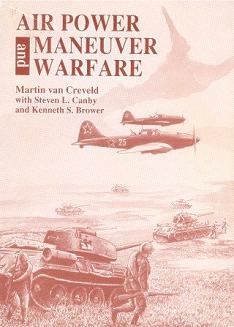
Air Power and Maneuver Warfare
Martin van Creveld, Steve Canby & Ken Brower
268 pages including index
published in 1994
Air Power and Maneuver Warfare is a strange book. At first it seems to be just a theoretical and historical overview of how air power and maneuver warfare fit together, but something seemed off from the start. This book was commissioned by the US Airforce's Air War College just after the Cold War had ended and more importantly, the US military establishment finally started to be convinced of this. It's a political document as much as a theoretical one, written for an audience that's supposed to be familiar with the theory of "maneuver warfare" (sic) but who do needed to be convinced of the argument Creveld and his co-authors are putting forward.
Said argument seems to be that the US Army needs to move away from its historical attrition warfare, linear orientation towards a more flexible maneuver orientated attitude, to be better able to deal with the challenges a post-Cold War world will throw at it. Meanwhile the airforces also need to shift towards a more tactical support role for the army rather than being obsessed with strategic air warfae and air defence suppression. This latter is not a new criticism of course, as ever since the USAF became a seperate arm of the armed forces it has been accused of neglecting tactical air support. The irony of it all is that while van Creveld and his co-authors (politely) argue that the then current strategic orientation of the US Armed Forces is outdated and inadequate to deal with the complexities of a post-Cold War world, their own recommendations are just as much a product of Cold War thinking, assuming that potential opponents will need to be and can be defeated by conventional military operations.
The reality of the last two decades has for the most part put the lie to this assumption, with the sole exception of the opening phase of the War on Iraq. Most conflicts the US has involved itself in have been limited conflict, fighting guerilla forces rather than conventional armies and where the sort of strategic air support van Creveld et all were denouncing has been rather important for the success of these operations. Some lip service is given in the introduction to this sort of warfare, but on the whole the book only talks about traditional warfare.
Which is probably not that surprising, written as it has been between the succesful conclusion of the First Gulf War and the US marine landings in Somalia, before things went sour there. The Gulf War was the final hurrah of the Cold War US Army, a vindication of their training, equipment and tactics; it was not quite the war it was taught to fight, but it was the type of war it was taught to fight. It's in that context that Air Power and Maneuver Warfare was written, which explains its emphasis on conventional warfare rather than the kind of operations the US army would fight in reality. It's also written without the benefit of access to Soviet archives that later historians/military theorists would've have, so misestimates a lot of the Soviet experiences in World War Two, as well as during the Cold War, still holding the conventional view that in a conventional war in Germany NATO would've been toast against the Warsaw Pact.
Air Power and Maneuver Warfare starts with a short overview of the theory of maneuver warfare in the first chapter, from its inception in the campaigns of Napoleon through the refinements theorists like von Clausewitz put it thorugh. The next three chapters then looks at the historical examples of the German Blitzkrieg campaigns in WWII and the Soviet response later in the war, together with the Israeli experiences in 1967 and 1973 to see how air power has been used and should be used in maneuver warfare. The concluding chapter than takes the conclusions reached and applies them to the US Army in the nineties and how it should re-organise itself, before looking in an appendix at how the just concluded Gulf War measured up. Finally, in a seperate part of the book, the Air War College responds to van Creveld and his co-authors, criticising their critique. This part is not fully integrated in the rest of the book and though it has its points (frex, in how van Creveld ignores the political context in which the Gulf War took place and how this impacts strategy) but is too short and sketchy to convince.
In short, this was a propaganda attempt that didn't quite convince, largely due to van Creveld's own blindspots. Hindsight is 20/20, but even at the time it should've been clear that the military context the book was written for no longer existed.
Webpage created 31-12-2011, last updated 02-01-2012.